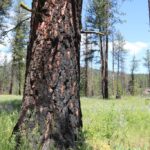Active Management and Prescribed Fire
Posted: July 6, 2017Source: The Forest Blog By Russ Vaagen

From: The ForestBlog
There’s a great deal of talk in today’s forest management circles about the use of prescribed fire as a tool to manage forests. Fire can certainly be a great tool to reduce forest fuels and maintain tree spacing. It’s been used by mother nature for eons. So much so that many tree species like Ponderosa Pine and Western Larch have become resistant to fire in order to survive the regular intervals of lightning caused fires.
Prescribed fire should be used in conjunction with active forest management. There are certainly areas where fire might be used on it’s own. It’s ideally performed in the front country with established road systems. In these areas we can commercially thin or log these areas to achieve historical spacing. The next season it could be very beneficial to conduct prescribed fire.
Fire is the reintroduction of a natural process that will allow the forests to recover. Using a combination of active management and prescribed fire gives our forests a great opportunity to become healthy once again. This is especially important in fire-prone regions where fire has been excluded for far too long. Creating a dire situation where the options are either actively manage the forest to health or leave it to inevitable catastrophic wildfire.
Location Matters
Not all areas require prescribed fire after active management. Prescribed fire is a great tool, but not required to regain forest health in all areas. Even in regions that are prone to regular fire intervals, there are specifc forests that do not need to be burned to return to historical, natural conditions. These forests get back to health best with active management with tools like thinning and collaboratively shaped logging prescriptions. Theses areas are identified by the mature, late successional tree species not being fire resistant, like Western Red Cedar.
The most important point is that prescribed fire needs to be a tool that works in conjunction with active management. Land managers should understand that the most impact in achieved when both tools are layered together. Either tool on their own may not deliver the value to the landscape that they can provide in concert with one another in the right location.

